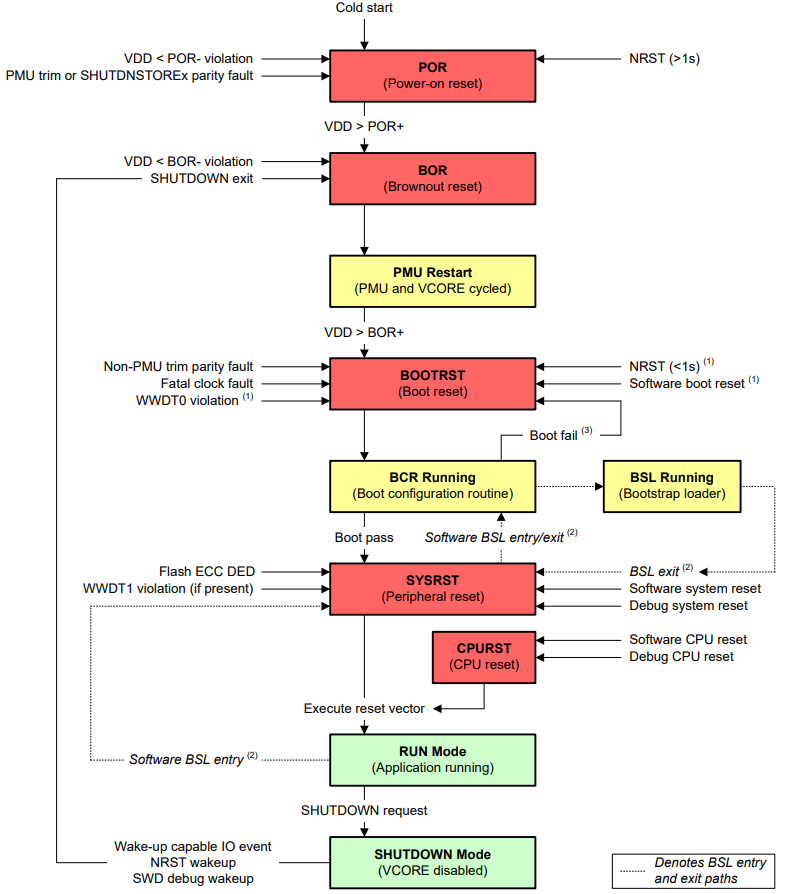SLAAEF9 November 2023 MSPM0L1306
- 1
- Abstract
- Trademarks
- 1MSPM0 Portfolio Overview
-
2Ecosystem And Migration
- 2.1 Ecosystem Comparison
- 2.2 Migration Process
- 2.3 Example
- 3Core Architecture Comparison
- 4Digital Peripheral Comparison
- 5Analog Peripheral Comparison
3.3 Power UP and Reset Summary and Comparison
Both RL78 devices and MSPM0 devices have the minimum operating voltage and have modules in place to make sure that the device starts up properly by holding the device or portions of the device in a reset state. Table 3-5 shows a comparison on how this is done between the two families and what modules control the power up process and reset across the families.
| RL78 | MSPM0 | ||
|---|---|---|---|
| POR (Power-On Reset Circuit) (1) | Rise detection: VDD>VPOR, POR reset
signal is released Fall detection: VDD<VPDR, POR reset signal is generated |
Power-On Reset (POR) | Rise detection: VDD>POR+, POR state is
released, and bandgap reference and BOR is started Fall detection: VDD<POR-, device is held in POR state |
| LVD (Voltage Detector)-Reset mode | Rise detection: VDD>VLVD, LVD reset
signal is released Fall detection: VDD<VLVD, LVD reset signal is generated |
Brownout Reset (BOR)- 0 level (2) | Rise detection: VDD>BOR0+, Device continues the boot process, and PMU is started Fall detection: VDD<BOR0-, Device is held in BOR state. |
| LVD (Voltage Detector)-Interrupt and reset mode | Rise detection: VDD>VLVDH, LVD reset
signal is released Fall detection: 1) VDD<VLVDH: an interrupt request signal is generated 2) VDD<VLVDL: LVD reset signal is generated |
Brownout Reset (BOR)- 1 to 3 level (2) | Fall detection: 1) VDD<BORx- (x=1, 2, 3), an interrupt request is generated, and the BOR circuit automatically switches the BOR threshold level to BOR0. 2) VDD<BOR0-, Device is held in BOR state |
| LVD (Voltage Detector)-Interrupt mode | Rise detection: VDD>VLVD, LVD reset
signal is released After the LVD reset is released, an interrupt request signal is generated when VDD>VLVD or VDD<VLVD |
N/A | N/A |
| RTCPOR (RTC Power-on Reset) | Reset of the RTC and XT1 oscillator by comparison of supply voltage of the RTCPOR circuit and detection voltage | RTC and associated clocks are reset through BOOTRST, BOR, or POR | |
The relationship between various voltage thresholds of RL78 is: VPDR < VPOR <Low limit of operation voltage < VLVDL < VLVDH. The relationship between various voltage thresholds of MSPM0 is: POR- < POR+ < BOR0- < BOR0+, and BOR0+ is the specified VDD minimum to enable correct operation of internal circuits.
Figure 3-1 shows the MSPM0 Reset function. MSPM0 devices have five reset levels: Power-on reset (POR), Brownout reset (BOR), Boot reset (BOOTRST), System reset (SYSRST) and CPU reset (CPURST).
 Figure 3-1 MSP Reset Function
Figure 3-1 MSP Reset Function